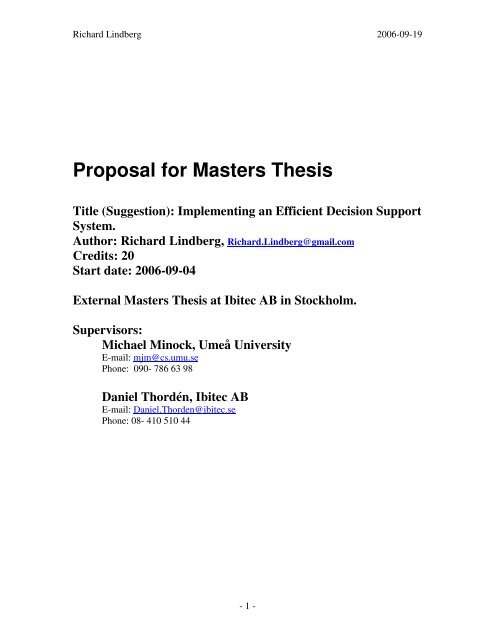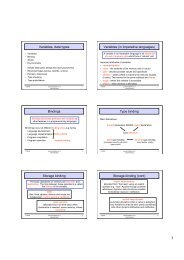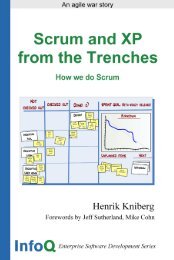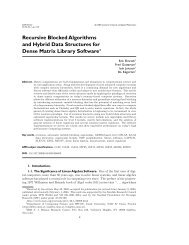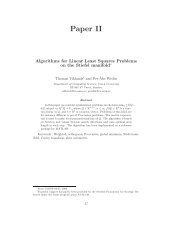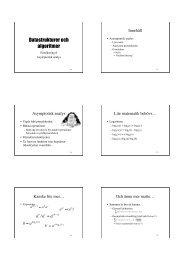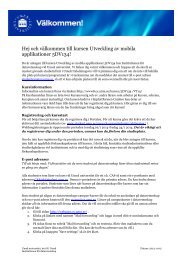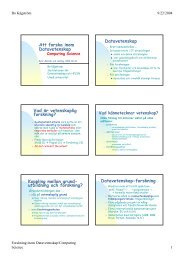Proposal for Masters Thesis
Proposal for Masters Thesis
Proposal for Masters Thesis
You also want an ePaper? Increase the reach of your titles
YUMPU automatically turns print PDFs into web optimized ePapers that Google loves.
Richard Lindberg 2006-09-19<strong>Proposal</strong> <strong>for</strong> <strong>Masters</strong> <strong>Thesis</strong>Title (Suggestion): Implementing an Efficient Decision SupportSystem.Author: Richard Lindberg, Richard.Lindberg@gmail.comCredits: 20Start date: 2006-09-04External <strong>Masters</strong> <strong>Thesis</strong> at Ibitec AB in Stockholm.Supervisors:Michael Minock, Umeå UniversityE-mail: mjm@cs.umu.sePhone: 090- 786 63 98Daniel Thordén, Ibitec ABE-mail: Daniel.Thorden@ibitec.sePhone: 08- 410 510 44- 1 -
Richard Lindberg 2006-09-19Introduction ___________________________________________________________ 3Per<strong>for</strong>mance study __________________________________________________________ 3Decision support system _____________________________________________________ 3Goal__________________________________________________________________ 3Method _______________________________________________________________ 3Literature _____________________________________________________________ 5Books _____________________________________________________________________ 5Articles and Reports ________________________________________________________ 5- 2 -
Richard Lindberg 2006-09-19IntroductionThis thesis will contain two parts. One theoretical where I examine the per<strong>for</strong>manceaspects of data warehousing and which algorithms and indexing techniques that areavailable to use on data warehouses. The second part is a development of a decisionsupport system (DSS) <strong>for</strong> Ibitec AB where I make use of the theoretical knowledgegained in the study to make it efficient. The DSS should also be based on an earlier studyconducted by two students, Sebastian Bolling and Linus Dolk from the University ofLinköping, at Ibitec AB who lay out the foundation of such a system based on IbitecAB’s organization and business goals.Per<strong>for</strong>mance studyOne of the problems in data warehousing is efficiency; this is due to the, often very large,datasets that warehousing queries are computing aggregates over. Typical queries involvecalculating aggregate functions over large datasets to find values over a certain threshold;such queries are called iceberg queries. These queries are often made on an ad hoc basissince the person querying the data warehouse does not necessarily know whichin<strong>for</strong>mation he or she is looking <strong>for</strong>. That makes it hard to determine in advance whichqueries that will be used and, because of that, hard to cache queries to speed up theprocess which in turn makes the indexing technique and algorithms used more important.Decision support systemMany companies these days make use of various DSS to make better decisions faster.These systems are based on business data gathered over time and measured againstcertain per<strong>for</strong>mance indicators. The foundation in a DSS is a data warehouse with anumber of cubes that has been worked out to suit the particular organization duringinterviews with decision makers and analysts.GoalThe ultimate goal of the project is to build a DSS <strong>for</strong> Ibitec AB based on source data ontheir organization that they have gathered. The system should be based on an earlierthesis written by two students at the University of Linköping where they analyzed IbitecAB’s organization and business plan and also conducted interviews with the decisionmakers to extract the important per<strong>for</strong>mance indicators and measures. Taking theirconclusions in consideration I will develop the system they laid the foundation <strong>for</strong> duringtheir time at Ibitec AB.Besides the above goal the warehouse should be implemented using efficient indexingtechniques and algorithms as far as the development tools provided allows.MethodTo achieve this goal I will start with a study of what indexing techniques and algorithmsthat are available <strong>for</strong> use on data warehouses. When I have enough in<strong>for</strong>mation about thisI will work through the material that has been provided by Sebastian Bolling and LinusDolk in their report. With that in<strong>for</strong>mation in mind I will start the development of the- 3 -
Richard Lindberg 2006-09-19DSS that matches the foundation they have laid out and also is implemented with theconclusions I have reached in my study in mind.The DSS will be developed only with the products that are included in Microsoft’sbusiness suit since this is where Ibitec AB has focus. A possible implementation modelusing these products is depicted below where the arrows represent dataflow.Web based user interfaceprobably using MicrosoftSharePoint Portal.Microsoft Per<strong>for</strong>mancePointsServer. Analysis software.Microsoft Analysis Services. Data Cubes.Microsoft Integration Services. ETLSoftware.ExcelfilesRelationaldata… Data Sources ….Other- 4 -
Richard Lindberg 2006-09-19LiteratureBooksMaking Better Business Intelligence Decisions Faster, Elizabeth Witt, MichaelLuckewic, Microsoft Press, 2002.This book will be very helpful during the interview phase of this project. It covers thetheoretical part of Business Intelligence, namely which people are involved, how the BIdecisions are made and what questions are relevant to answer.Datamining, Concepts and Techniques, Jiawei Han, Micheline Kamber, AcademicPress, 2001.This book covers the theoretical part of data mining and data warehousing. It will be ahelpful resource in looking at algorithms that are used in data mining and datawarehousing. It will give me a look at the concepts and techniques used in warehousing.Fundamentals of Database Systems 4 th ed, Elmasri, Navathe, Addison-Wesley, 2004.This book will be the primary source <strong>for</strong> in depth knowledge of indexing and algorithms<strong>for</strong> relational databases and I think it will become a valuable source <strong>for</strong> in<strong>for</strong>mationduring the course of this project.Delivering Business Intelligence With Microsoft SQL Server 2005, Brian Larson,Osborne, 2006With a focus on business intelligence with MS SQL Server 2005 this book will help mework in the development environment usedArticles and ReportsIndexing Techniques <strong>for</strong> Data Warehouses’ Queries. Sirirut Vanichayobon, LeGruenwald, University of Oklahoma.Article about the indexing techniques used in data warehousing. They talk about what toconsider when deciding which type of index to use and which indexes that are commonlyused in data warehouses now.Computing Iceberg Queries Efficiently, Fang, Shivakumar, Garcia-Molina,Motwani, Ullman, Dept. of Comp. Sci, Stan<strong>for</strong>d.- 5 -
Richard Lindberg 2006-09-19Discusses the different aspects of data warehousing versus relational databases and thedifferences in the queries executed over these databases. They propose algorithms toexecute these queries efficiently.Computing Data Cubes Efficiently, Harinarayan, Rajaraman, Ullman, Stan<strong>for</strong>dUniversity.Discusses algorithms <strong>for</strong> optimal selection of views to materialize in data warehouses.Improved Query Per<strong>for</strong>mance with Variant Indexes, O’Neil, Quass, University ofMassachusetts and University of Stan<strong>for</strong>d.Discusses various indexing techniques on data warehouses and relational databases andalso suggests new types of indices.Beslutsstödssystem, en utvecklingsmetod. Bolling, Dolk, Linköpings universitet, C-uppsats.An analysis of Ibitec AB’s business model and company architecture and also whichper<strong>for</strong>mance indicators and measures that the decision makers at Ibitec AB wants.- 6 -


